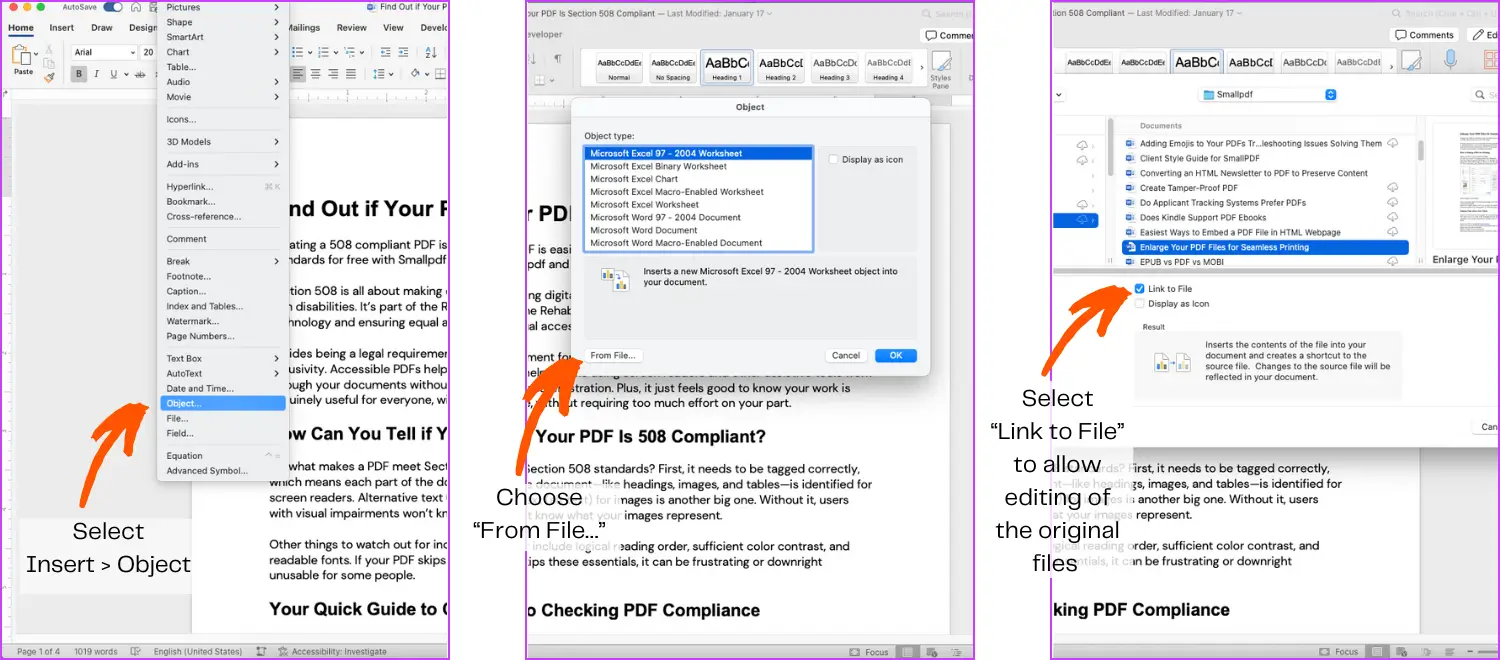
Merge Word documents in one click with two easy methods—one fast, online and free, the other built into Word itself if you’d rather stay offline.
The Quickest Way: Merge Word Docs With Smallpdf
The fastest way to merge Word files is with Smallpdf. There’s nothing to download, and no compatibility issues.
The first step is to convert your Word files to PDF. You can use the “Save As PDF” feature in Word, or drop them straight into our Word to PDF converter. Then:
- Drag and drop your PDFs into the Merge PDF tool.
- Choose between “Merge files” or “Merge pages.”
- Click “Merge PDF” on the next page.
- Click “Export As” and choose “Word” to download your file in Word format.

Smallpdf has the easiest method to merge two or more Word documents
It's also a great workaround if you're trying to merge DOCX files quickly from different sources. There are no limits on how many files you can upload to our free Word merger. And no need to install anything.
If you're working from your phone, the Smallpdf mobile app makes it just as easy. You can even snap a photo of a paper doc, add it to your digital files, and download everything as a single Word file.
And if you're wondering about security, this is a secure Word merger. Every file transfer is protected by TLS encryption, and we automatically delete all documents after one hour. Your files stay private.
How many Word files can I merge at once?
With a Pro subscription, you can upload and merge as many as you like, and you can even reorder Word files before merging. On the free plan, batch uploads aren’t supported, and you are limited to converting or merging two files a day.
Not ready to commit to Pro? Sign up for a free 7-day trial to try it out.
If your final file is a bit too large to email or upload, you can run it through our Compress PDF tool before converting it back to Word.
Merge Word Documents in Microsoft Word (Text from File)
This takes a few more clicks, but it gets the job done.
- Open the first Word document. You start with a blank doc too.
- Place your cursor exactly where you want the new content to begin. This is crucial for proper document flow.
- Click “Insert” and then “Object,” which might be hidden under “Text.”
- Select “Text from file.”
- Choose your files (to select multiple files, hold Ctrl while clicking), then click “Insert.”

On macOS, “Text from file” is simply “From File...”
Still want to update the originals later? No problem. You can use the “Insert as Link” or “Link to File” option when inserting the other documents. Any changes made to the source file(s) will now automatically update in the merged file too.
This works in Word 2007 and later on both Windows and Mac. Just watch out for minor formatting issues, as sometimes section breaks, headers, or style settings don't play nice. Occasionally a bit of cleanup may be needed.
Where is “Text from File” in Word?
In Word's Insert tab, click the arrow next to Object, then select “Text from File.” On Mac, look for “From File...” instead.
Keep Documents in the Right Order
Here’s a pro tip to keep things straight: Number your files (01_intro.docx, 02_chapter1.docx) before selecting to ensure correct order. Keep in mind that, when selecting multiple files, they'll merge in the order they appear in your file list, so proper naming saves you from having to reorder later.
Merge Versions with Tracked Changes (Compare > Combine)
If you're merging feedback from multiple people, things might get a little crowded with tracked changes and comments. You can clean it up by accepting or rejecting changes before merging or use Word's “Compare and Combine” tools under the Review tab for a more controlled workflow. This lets you merge revisions while keeping track of who changed what.
Can I Merge Word documents Without Losing Formatting?
Converting to PDF first preserves formatting best. Word's Text from File adopts the main document's styles, which can change how your content looks.
Fix Formatting Issues After Merging Word Doc
Merging files can sometimes introduce hiccups, but far fewer than copying and pasting. This can happen when the files come from different templates. But don't panic if things look off. There are a few easy fixes you can apply for the following issues.
Page numbers restart or reset:
- Insert a continuous section break before the affected section.
- Click the first incorrect page number.
- Go to Insert > Page Numbers > Format Page Numbers.
- Select “Continue from previous section.”
Headers and footers disappear or change after merging:
- Double-click the header or footer area.
- Make sure “Link to Previous” is turned on (or off, if you need different headers per section).
Font or layout issues:
- Open the “Styles” pane in Word.
- Reapply consistent formatting or choose “Clear All” to reset problem areas.
Compatibility Issues With Old Word files (.doc or Macro-Enabled .docm)
- Save all files as .docx before merging.
Before sharing your merged file, run a final accessibility and quality check. Just open “Review > Check Accessibility” to run Word’s Accessibility Checker. It’ll flag formatting, contrast, or structure issues that could affect screen readers or assistive tools.
Why Merge Word Documents
If you've ever tried to copy and paste one Word file into another, you'll know how things can get messy. Fonts go rogue, spacing shifts, and suddenly everything's off.
Merging is the easiest way to combine multiple Word documents without risking formatting chaos when you're combining contracts, piecing together school handouts, or wrapping up a multi-part report.
Convert and Export Your Merged Document (PDF or Word)
Once your Word files are merged, you've got plenty of options. Converting to PDF format is often the best choice for preserving formatting, especially if your merged document will be shared or printed. You can easily convert your Word files to PDF, then export back to Word, Excel, or PowerPoint.
If you need to add highlights or notes to your merged file, just drop it into the Edit PDF tool. You don't need to bounce between programs—it's all right there with Smallpdf.
Split or Extract Pages from a Merged File
Need to separate sections later? If you want to extract certain chapters or pages from your merged document, you can split the file in seconds using our Split PDF tool. Perfect for when you realize you need individual sections after combining everything.
Can I merge PDFs and Word files together using Smallpdf?
Absolutely. Convert your Word files to PDF, then upload them alongside any existing PDFs using the Merge PDF tool. You can also export the merged result as a new Word document if you need to keep editing.
Is Smallpdf secure?
Because of our security protocols and fast processing, millions of people use our platform every month to merge, annotate, split, compress, and convert their documents. All file transfers are encrypted with TLS, and we remove all files from our servers after an hour of processing. We take file privacy seriously.
Merging documents shouldn't be a hassle. If you're already in Word, its built-in tools can work just fine. But when you want something easier, quicker, or a bit more flexible, Smallpdf's got your back. It's a cross-platform Word merger that works on any device, wherever you're working.



